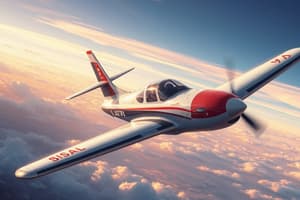Podcast
Questions and Answers
What dictates the size and weight of an aircraft?
What dictates the size and weight of an aircraft?
- Type of fuel used
- Number of windows in the cabin
- Structure of the aircraft
- Increased capacity (correct)
How can the gross weight of an airplane be estimated?
How can the gross weight of an airplane be estimated?
- By analyzing the engine power
- By counting the number of seats in the cabin
- By looking at the color of the aircraft
- By knowing the weight of payload, crew, fuel, and oil (correct)
Why does a larger fuselage indicate a larger aircraft?
Why does a larger fuselage indicate a larger aircraft?
- To lower the center of gravity
- To reduce the overall weight of the aircraft
- To increase the speed of the aircraft
- To accommodate more passengers and crew (correct)
What is crucial for the designer to know about the load an aircraft is about to carry?
What is crucial for the designer to know about the load an aircraft is about to carry?
Why might a designer have little or no control over the weight, size, or location of certain items in an aircraft?
Why might a designer have little or no control over the weight, size, or location of certain items in an aircraft?
What does the term 'payload' refer to in aviation?
What does the term 'payload' refer to in aviation?
Which of the following is considered part of the crew in aviation?
Which of the following is considered part of the crew in aviation?
How do military airplanes differentiate their payload from civil aircraft?
How do military airplanes differentiate their payload from civil aircraft?
What factor largely determines the gross weight of an aircraft?
What factor largely determines the gross weight of an aircraft?
How does the size of the crew affect the design of an aircraft?
How does the size of the crew affect the design of an aircraft?
What is used as an indicator for designing the size of an airplane?
What is used as an indicator for designing the size of an airplane?
Flashcards are hidden until you start studying
Study Notes
Aircraft Size and Weight Determinants
- Size and weight of an aircraft are primarily dictated by design requirements, purpose of the aircraft, and materials used in construction.
- Factors such as aerodynamics, structural integrity, performance specifications, and safety regulations also play significant roles.
Estimating Gross Weight
- Estimating gross weight can involve calculations based on design specifications, anticipated payload, and operational variables.
- Loads considered include fuel, passengers, cargo, and equipment, plus the aircraft's empty weight.
Fuselage Size and Aircraft Classification
- A larger fuselage is typically indicative of a larger aircraft as it generally accommodates more passengers, cargo, and fuel.
- It also often provides better aerodynamic performance and stability.
Importance of Load Knowledge in Design
- It's crucial for designers to know the load an aircraft will carry to ensure structural integrity and optimal performance.
- Accurate load estimations affect balance, center of gravity, and overall safety.
Control Over Aircraft Components
- Designers may have limited control over weight, size, or location of certain items due to regulatory standards, safety requirements, or existing technology constraints.
- External factors like customer specifications and component availability can also influence design decisions.
Payload Definition in Aviation
- The term 'payload' in aviation refers to the carrying capacity of an aircraft, including passengers, cargo, and any other load that contributes to its operational mission.
Crew Classification in Aviation
- Members classified as part of the crew in aviation typically include pilots, co-pilots, and flight engineers.
- Support staff such as cabin crew may also be considered part of the operational crew.
Payload Differentiation in Military vs. Civil Aircraft
- Military airplanes differentiate their payload by including weapons and equipment for tactical missions, while civil aircraft focus on transport of passengers and cargo.
- Military payloads are often mission-specific and can vary significantly between flights.
Determinants of Gross Weight
- The gross weight of an aircraft is largely determined by the aircraft's design requirements, including mission profile, operational range, and structural components.
Crew Size Impact on Design
- The size of the crew directly affects the design of an aircraft, as more crew members require additional space, equipment, and safety considerations.
- Larger crews may necessitate enhancements in seating layout and emergency exits.
Design Indicators for Aircraft Size
- Factors used as indicators in designing the size of an airplane include expected passenger capacity, distance to be flown, and specific mission requirements.
- Regulatory and performance criteria also contribute to resultant size decisions.
Studying That Suits You
Use AI to generate personalized quizzes and flashcards to suit your learning preferences.




